Stewardship: Comparing Block and Wilson Leadership Models
VerifiedAdded on 2023/01/19
|10
|2175
|74
Report
AI Summary
This report provides an in-depth analysis of the concept of stewardship, focusing on the models proposed by Peter Block and Kent R. Wilson. It begins with an executive summary outlining the report's objectives, which include understanding stewardship and comparing the approaches of Block and Wilson. The introduction explains the core ideas of stewardship, emphasizing the steward leader's responsibility for managing resources on behalf of others. The report then contrasts the Block model, which emphasizes relational and motivational leadership, with the Wilson model, which views stewardship as managing resources to achieve owner objectives. The analysis highlights the Wilson model as ideal, detailing the three lenses of ownership, motivation, and accountability. The report explains how Wilson's model integrates the steward with the individuals served, emphasizing the importance of training, resource management, and community building. The conclusion summarizes the key differences between the models, emphasizing Wilson's perspective on the steward's role and the complexities involved in managing resources and responsibilities. The report includes references to relevant literature supporting the analysis.
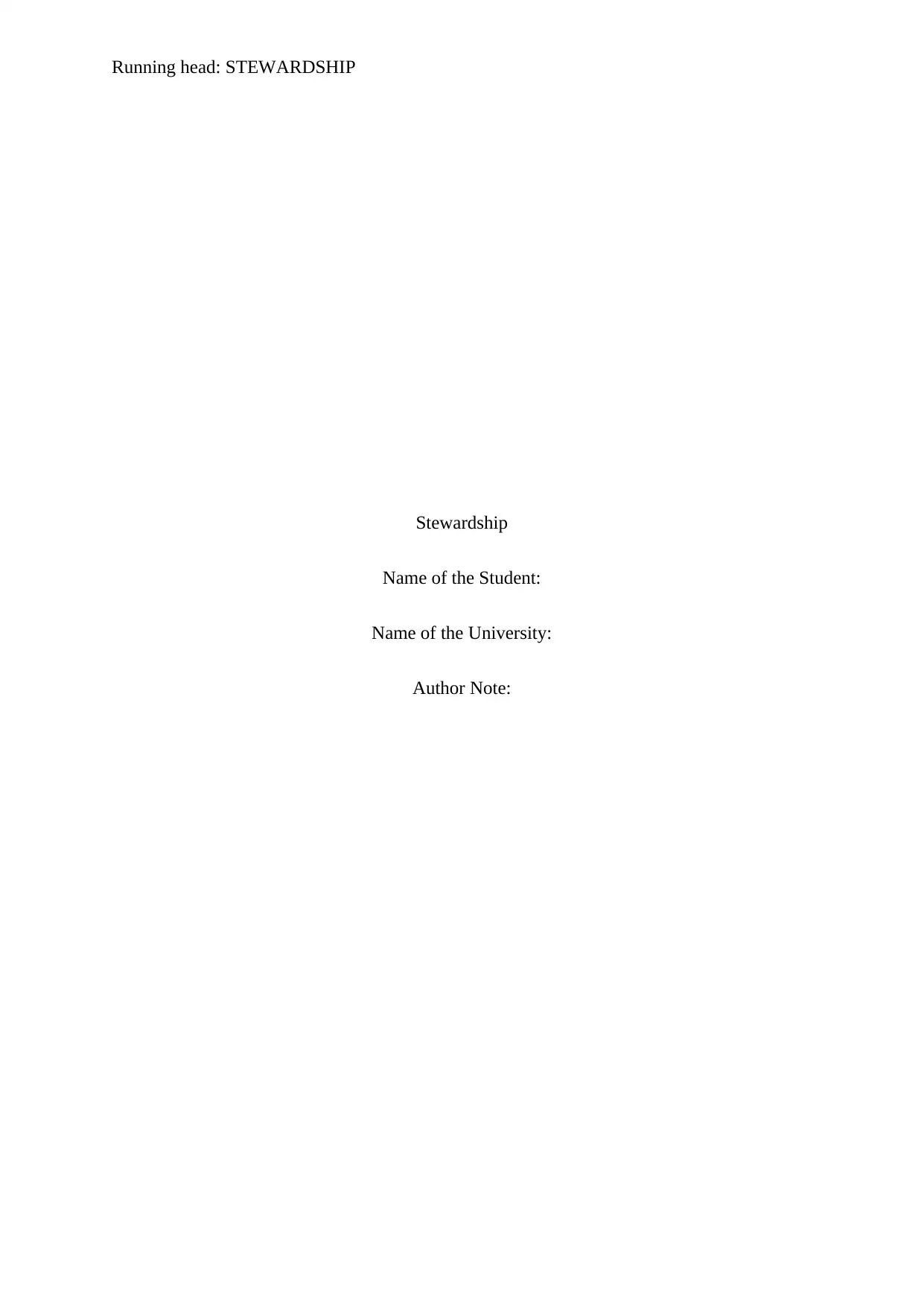
Running head: STEWARDSHIP
Stewardship
Name of the Student:
Name of the University:
Author Note:
Stewardship
Name of the Student:
Name of the University:
Author Note:
Paraphrase This Document
Need a fresh take? Get an instant paraphrase of this document with our AI Paraphraser
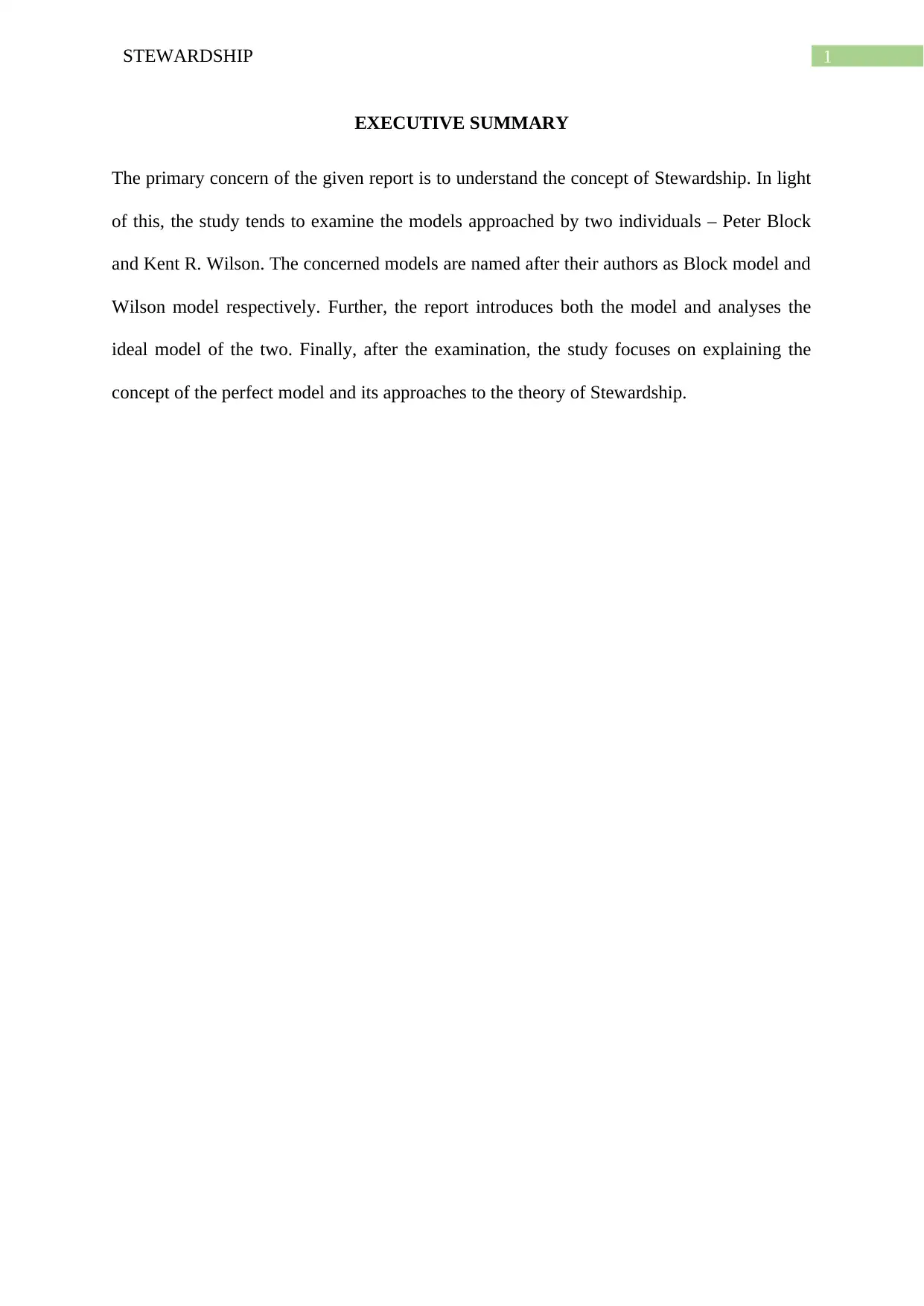
1STEWARDSHIP
EXECUTIVE SUMMARY
The primary concern of the given report is to understand the concept of Stewardship. In light
of this, the study tends to examine the models approached by two individuals – Peter Block
and Kent R. Wilson. The concerned models are named after their authors as Block model and
Wilson model respectively. Further, the report introduces both the model and analyses the
ideal model of the two. Finally, after the examination, the study focuses on explaining the
concept of the perfect model and its approaches to the theory of Stewardship.
EXECUTIVE SUMMARY
The primary concern of the given report is to understand the concept of Stewardship. In light
of this, the study tends to examine the models approached by two individuals – Peter Block
and Kent R. Wilson. The concerned models are named after their authors as Block model and
Wilson model respectively. Further, the report introduces both the model and analyses the
ideal model of the two. Finally, after the examination, the study focuses on explaining the
concept of the perfect model and its approaches to the theory of Stewardship.
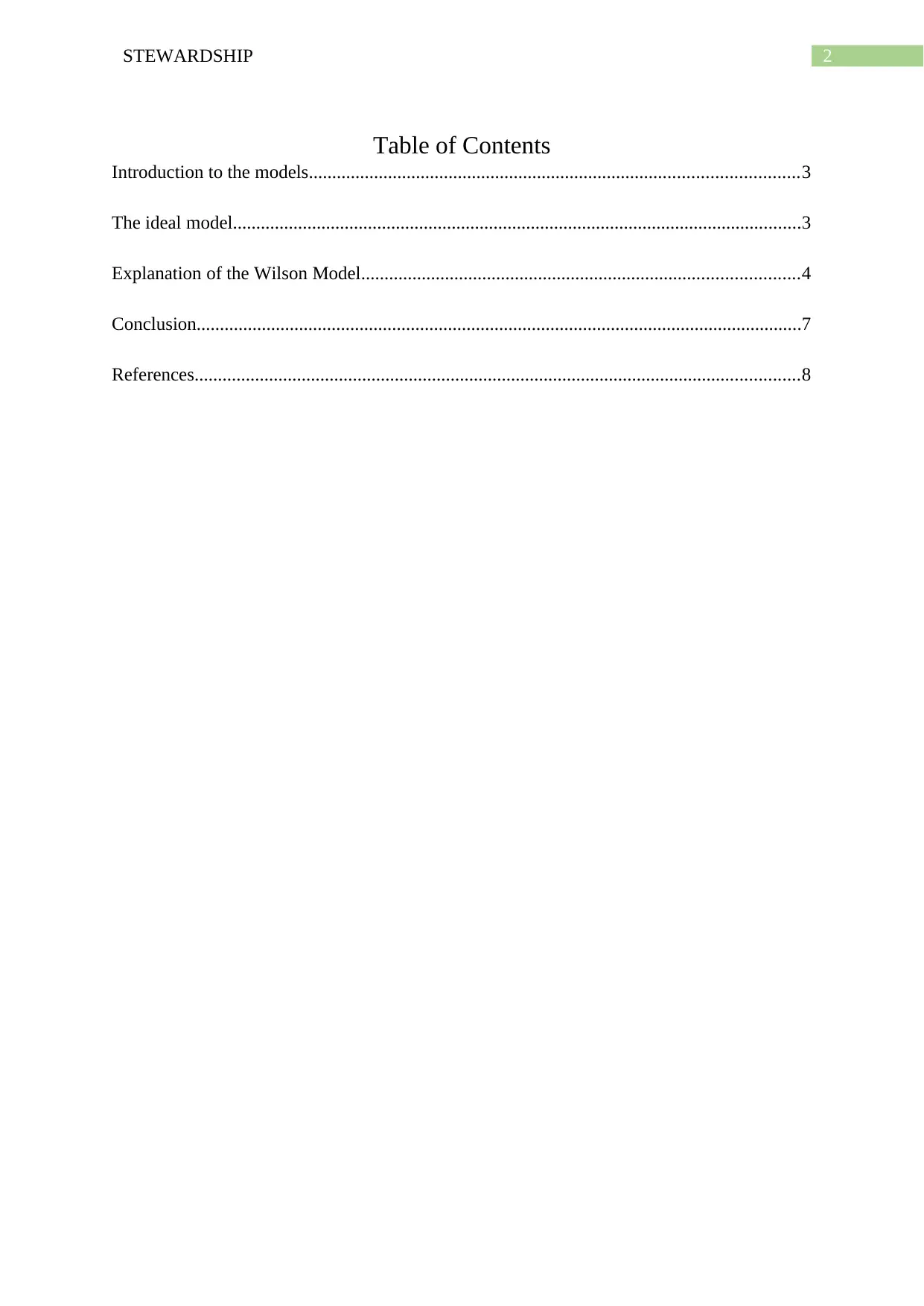
2STEWARDSHIP
Table of Contents
Introduction to the models.........................................................................................................3
The ideal model..........................................................................................................................3
Explanation of the Wilson Model..............................................................................................4
Conclusion..................................................................................................................................7
References..................................................................................................................................8
Table of Contents
Introduction to the models.........................................................................................................3
The ideal model..........................................................................................................................3
Explanation of the Wilson Model..............................................................................................4
Conclusion..................................................................................................................................7
References..................................................................................................................................8
⊘ This is a preview!⊘
Do you want full access?
Subscribe today to unlock all pages.

Trusted by 1+ million students worldwide
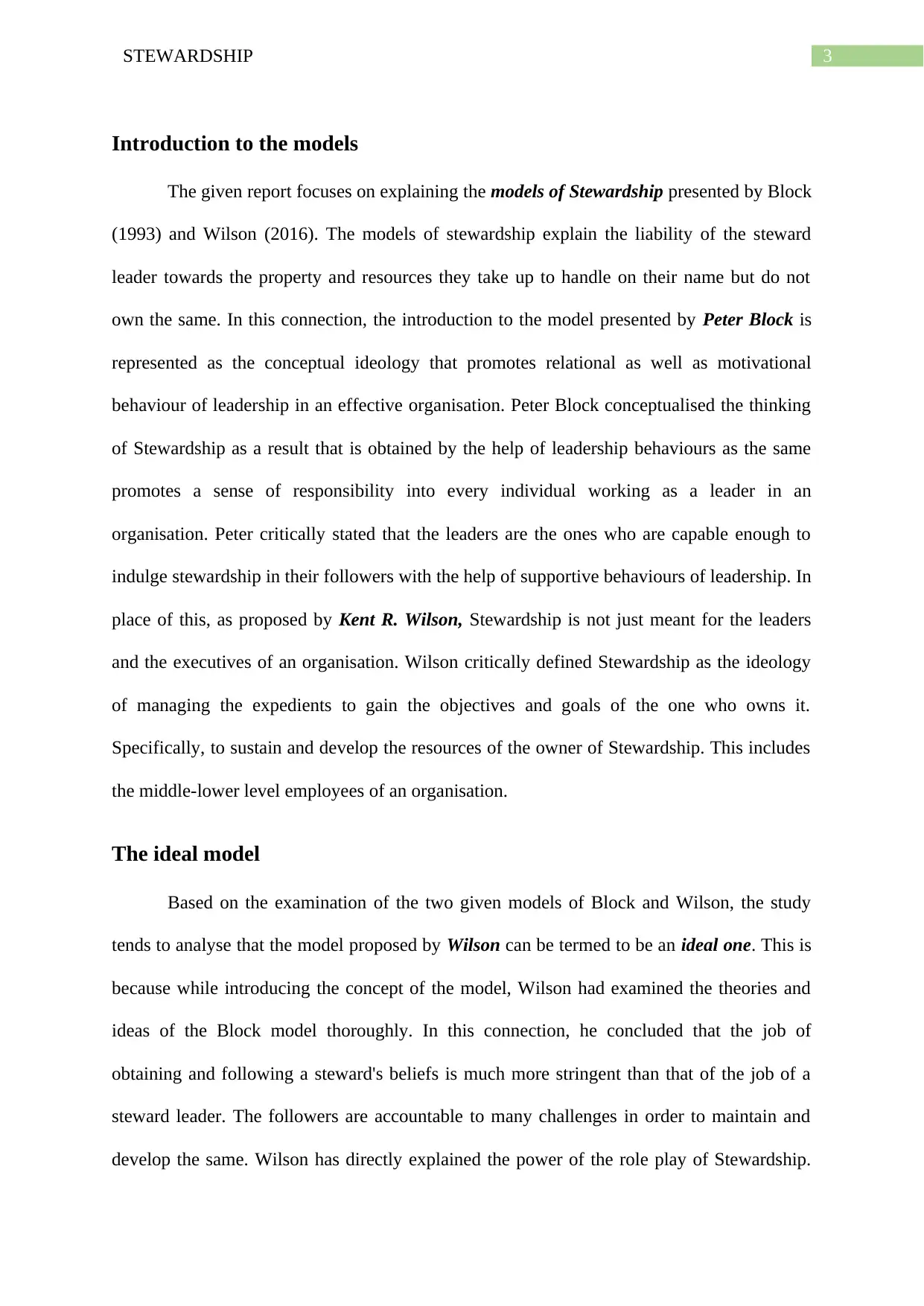
3STEWARDSHIP
Introduction to the models
The given report focuses on explaining the models of Stewardship presented by Block
(1993) and Wilson (2016). The models of stewardship explain the liability of the steward
leader towards the property and resources they take up to handle on their name but do not
own the same. In this connection, the introduction to the model presented by Peter Block is
represented as the conceptual ideology that promotes relational as well as motivational
behaviour of leadership in an effective organisation. Peter Block conceptualised the thinking
of Stewardship as a result that is obtained by the help of leadership behaviours as the same
promotes a sense of responsibility into every individual working as a leader in an
organisation. Peter critically stated that the leaders are the ones who are capable enough to
indulge stewardship in their followers with the help of supportive behaviours of leadership. In
place of this, as proposed by Kent R. Wilson, Stewardship is not just meant for the leaders
and the executives of an organisation. Wilson critically defined Stewardship as the ideology
of managing the expedients to gain the objectives and goals of the one who owns it.
Specifically, to sustain and develop the resources of the owner of Stewardship. This includes
the middle-lower level employees of an organisation.
The ideal model
Based on the examination of the two given models of Block and Wilson, the study
tends to analyse that the model proposed by Wilson can be termed to be an ideal one. This is
because while introducing the concept of the model, Wilson had examined the theories and
ideas of the Block model thoroughly. In this connection, he concluded that the job of
obtaining and following a steward's beliefs is much more stringent than that of the job of a
steward leader. The followers are accountable to many challenges in order to maintain and
develop the same. Wilson has directly explained the power of the role play of Stewardship.
Introduction to the models
The given report focuses on explaining the models of Stewardship presented by Block
(1993) and Wilson (2016). The models of stewardship explain the liability of the steward
leader towards the property and resources they take up to handle on their name but do not
own the same. In this connection, the introduction to the model presented by Peter Block is
represented as the conceptual ideology that promotes relational as well as motivational
behaviour of leadership in an effective organisation. Peter Block conceptualised the thinking
of Stewardship as a result that is obtained by the help of leadership behaviours as the same
promotes a sense of responsibility into every individual working as a leader in an
organisation. Peter critically stated that the leaders are the ones who are capable enough to
indulge stewardship in their followers with the help of supportive behaviours of leadership. In
place of this, as proposed by Kent R. Wilson, Stewardship is not just meant for the leaders
and the executives of an organisation. Wilson critically defined Stewardship as the ideology
of managing the expedients to gain the objectives and goals of the one who owns it.
Specifically, to sustain and develop the resources of the owner of Stewardship. This includes
the middle-lower level employees of an organisation.
The ideal model
Based on the examination of the two given models of Block and Wilson, the study
tends to analyse that the model proposed by Wilson can be termed to be an ideal one. This is
because while introducing the concept of the model, Wilson had examined the theories and
ideas of the Block model thoroughly. In this connection, he concluded that the job of
obtaining and following a steward's beliefs is much more stringent than that of the job of a
steward leader. The followers are accountable to many challenges in order to maintain and
develop the same. Wilson has directly explained the power of the role play of Stewardship.
Paraphrase This Document
Need a fresh take? Get an instant paraphrase of this document with our AI Paraphraser
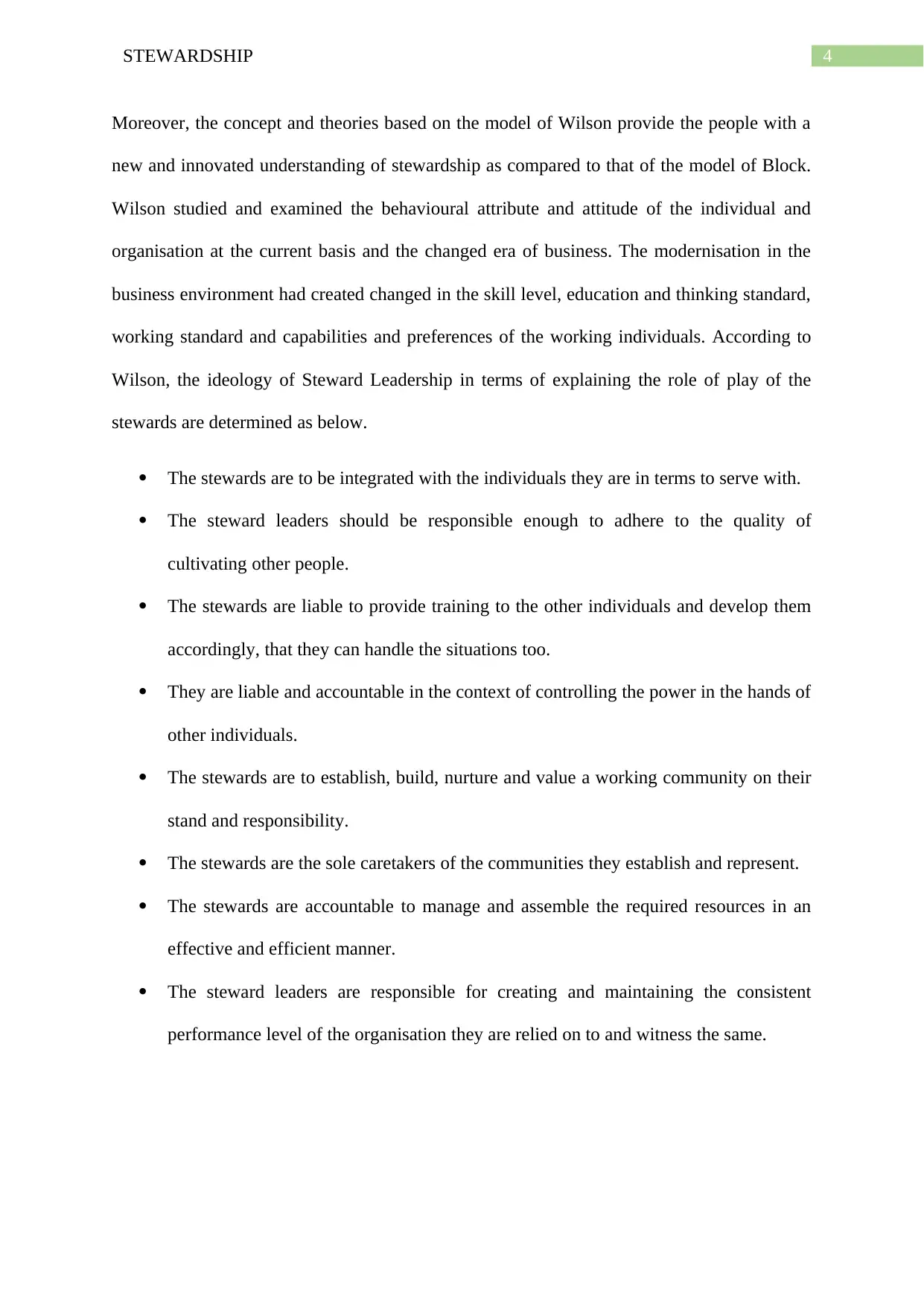
4STEWARDSHIP
Moreover, the concept and theories based on the model of Wilson provide the people with a
new and innovated understanding of stewardship as compared to that of the model of Block.
Wilson studied and examined the behavioural attribute and attitude of the individual and
organisation at the current basis and the changed era of business. The modernisation in the
business environment had created changed in the skill level, education and thinking standard,
working standard and capabilities and preferences of the working individuals. According to
Wilson, the ideology of Steward Leadership in terms of explaining the role of play of the
stewards are determined as below.
The stewards are to be integrated with the individuals they are in terms to serve with.
The steward leaders should be responsible enough to adhere to the quality of
cultivating other people.
The stewards are liable to provide training to the other individuals and develop them
accordingly, that they can handle the situations too.
They are liable and accountable in the context of controlling the power in the hands of
other individuals.
The stewards are to establish, build, nurture and value a working community on their
stand and responsibility.
The stewards are the sole caretakers of the communities they establish and represent.
The stewards are accountable to manage and assemble the required resources in an
effective and efficient manner.
The steward leaders are responsible for creating and maintaining the consistent
performance level of the organisation they are relied on to and witness the same.
Moreover, the concept and theories based on the model of Wilson provide the people with a
new and innovated understanding of stewardship as compared to that of the model of Block.
Wilson studied and examined the behavioural attribute and attitude of the individual and
organisation at the current basis and the changed era of business. The modernisation in the
business environment had created changed in the skill level, education and thinking standard,
working standard and capabilities and preferences of the working individuals. According to
Wilson, the ideology of Steward Leadership in terms of explaining the role of play of the
stewards are determined as below.
The stewards are to be integrated with the individuals they are in terms to serve with.
The steward leaders should be responsible enough to adhere to the quality of
cultivating other people.
The stewards are liable to provide training to the other individuals and develop them
accordingly, that they can handle the situations too.
They are liable and accountable in the context of controlling the power in the hands of
other individuals.
The stewards are to establish, build, nurture and value a working community on their
stand and responsibility.
The stewards are the sole caretakers of the communities they establish and represent.
The stewards are accountable to manage and assemble the required resources in an
effective and efficient manner.
The steward leaders are responsible for creating and maintaining the consistent
performance level of the organisation they are relied on to and witness the same.
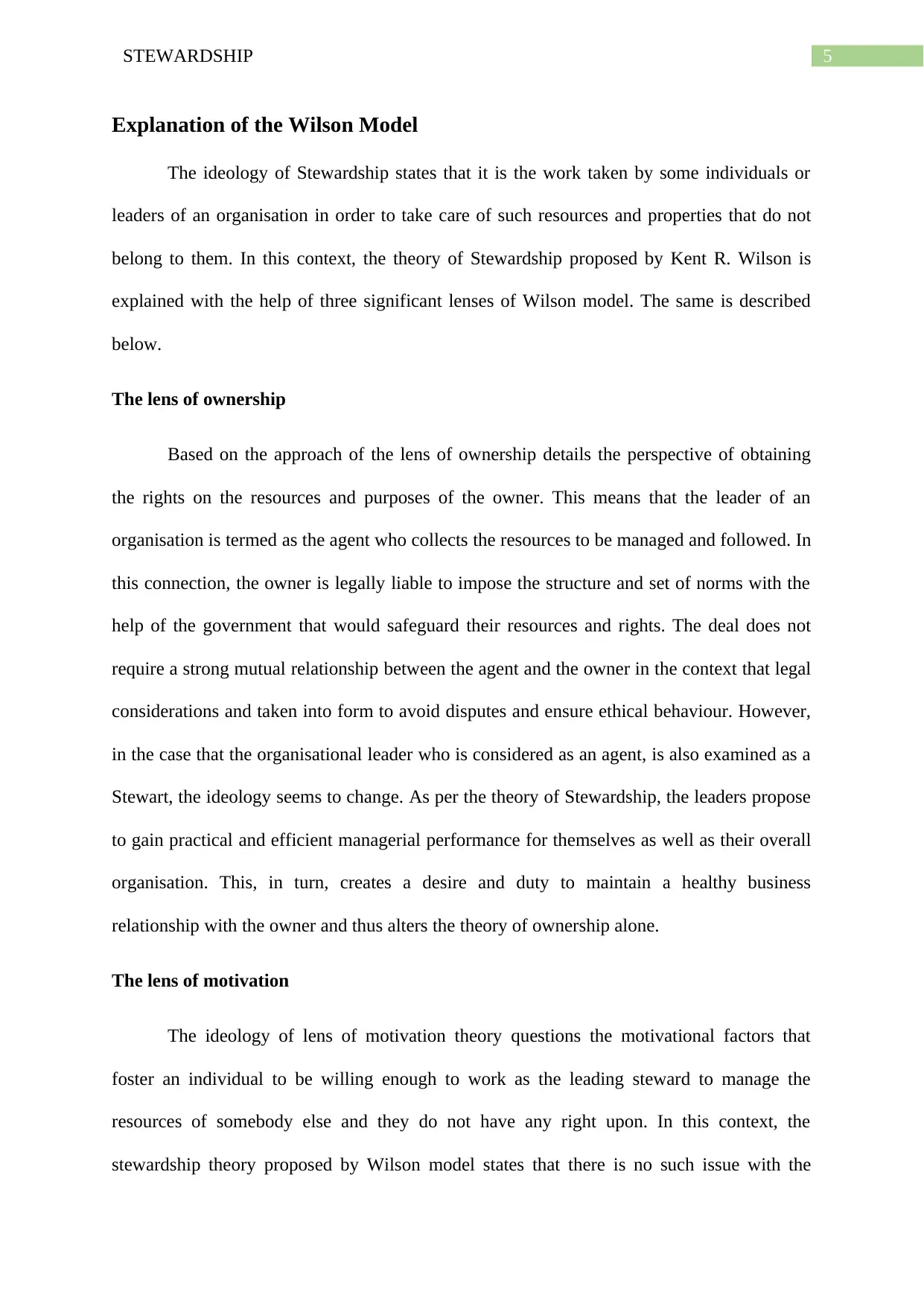
5STEWARDSHIP
Explanation of the Wilson Model
The ideology of Stewardship states that it is the work taken by some individuals or
leaders of an organisation in order to take care of such resources and properties that do not
belong to them. In this context, the theory of Stewardship proposed by Kent R. Wilson is
explained with the help of three significant lenses of Wilson model. The same is described
below.
The lens of ownership
Based on the approach of the lens of ownership details the perspective of obtaining
the rights on the resources and purposes of the owner. This means that the leader of an
organisation is termed as the agent who collects the resources to be managed and followed. In
this connection, the owner is legally liable to impose the structure and set of norms with the
help of the government that would safeguard their resources and rights. The deal does not
require a strong mutual relationship between the agent and the owner in the context that legal
considerations and taken into form to avoid disputes and ensure ethical behaviour. However,
in the case that the organisational leader who is considered as an agent, is also examined as a
Stewart, the ideology seems to change. As per the theory of Stewardship, the leaders propose
to gain practical and efficient managerial performance for themselves as well as their overall
organisation. This, in turn, creates a desire and duty to maintain a healthy business
relationship with the owner and thus alters the theory of ownership alone.
The lens of motivation
The ideology of lens of motivation theory questions the motivational factors that
foster an individual to be willing enough to work as the leading steward to manage the
resources of somebody else and they do not have any right upon. In this context, the
stewardship theory proposed by Wilson model states that there is no such issue with the
Explanation of the Wilson Model
The ideology of Stewardship states that it is the work taken by some individuals or
leaders of an organisation in order to take care of such resources and properties that do not
belong to them. In this context, the theory of Stewardship proposed by Kent R. Wilson is
explained with the help of three significant lenses of Wilson model. The same is described
below.
The lens of ownership
Based on the approach of the lens of ownership details the perspective of obtaining
the rights on the resources and purposes of the owner. This means that the leader of an
organisation is termed as the agent who collects the resources to be managed and followed. In
this connection, the owner is legally liable to impose the structure and set of norms with the
help of the government that would safeguard their resources and rights. The deal does not
require a strong mutual relationship between the agent and the owner in the context that legal
considerations and taken into form to avoid disputes and ensure ethical behaviour. However,
in the case that the organisational leader who is considered as an agent, is also examined as a
Stewart, the ideology seems to change. As per the theory of Stewardship, the leaders propose
to gain practical and efficient managerial performance for themselves as well as their overall
organisation. This, in turn, creates a desire and duty to maintain a healthy business
relationship with the owner and thus alters the theory of ownership alone.
The lens of motivation
The ideology of lens of motivation theory questions the motivational factors that
foster an individual to be willing enough to work as the leading steward to manage the
resources of somebody else and they do not have any right upon. In this context, the
stewardship theory proposed by Wilson model states that there is no such issue with the
⊘ This is a preview!⊘
Do you want full access?
Subscribe today to unlock all pages.

Trusted by 1+ million students worldwide
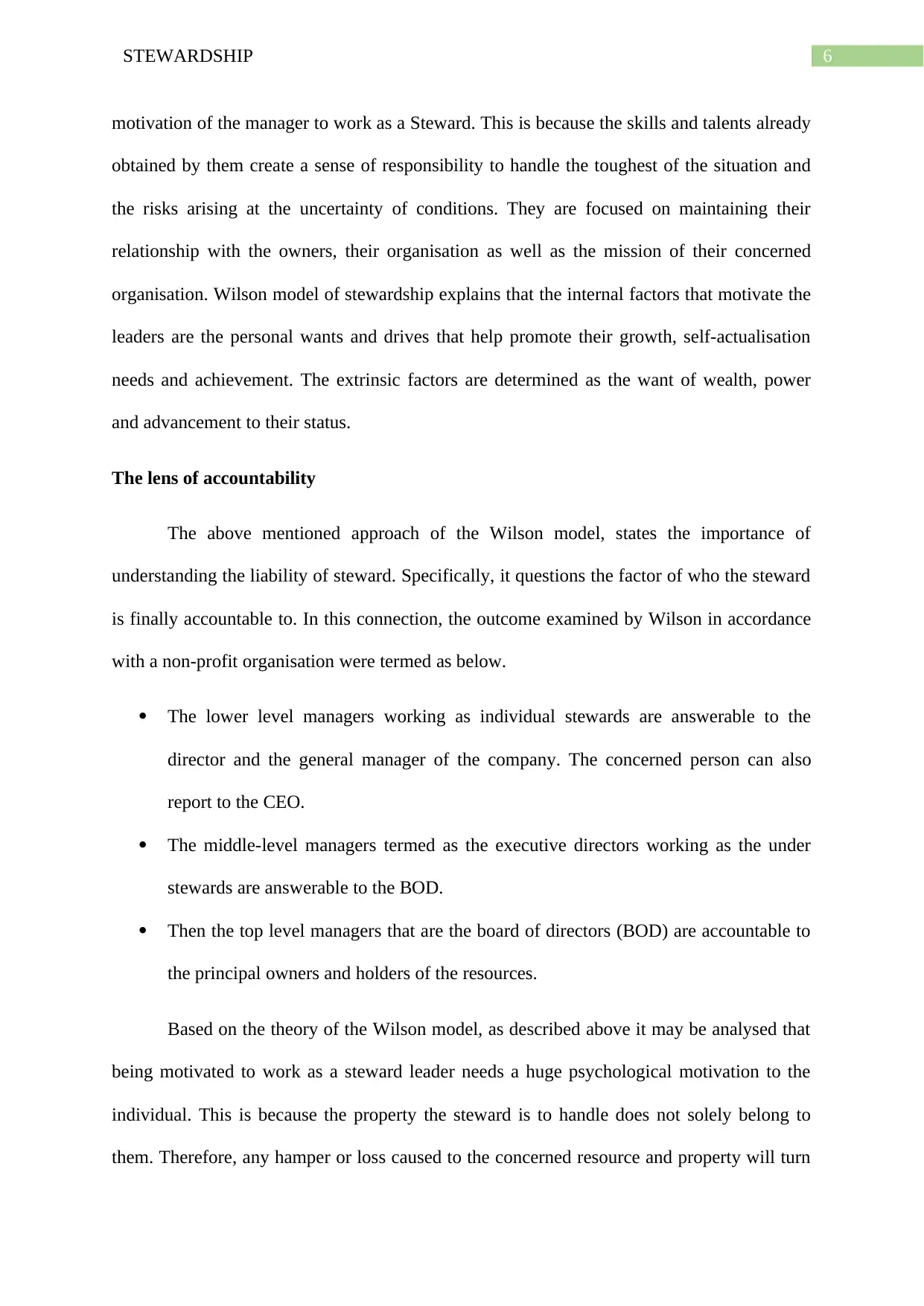
6STEWARDSHIP
motivation of the manager to work as a Steward. This is because the skills and talents already
obtained by them create a sense of responsibility to handle the toughest of the situation and
the risks arising at the uncertainty of conditions. They are focused on maintaining their
relationship with the owners, their organisation as well as the mission of their concerned
organisation. Wilson model of stewardship explains that the internal factors that motivate the
leaders are the personal wants and drives that help promote their growth, self-actualisation
needs and achievement. The extrinsic factors are determined as the want of wealth, power
and advancement to their status.
The lens of accountability
The above mentioned approach of the Wilson model, states the importance of
understanding the liability of steward. Specifically, it questions the factor of who the steward
is finally accountable to. In this connection, the outcome examined by Wilson in accordance
with a non-profit organisation were termed as below.
The lower level managers working as individual stewards are answerable to the
director and the general manager of the company. The concerned person can also
report to the CEO.
The middle-level managers termed as the executive directors working as the under
stewards are answerable to the BOD.
Then the top level managers that are the board of directors (BOD) are accountable to
the principal owners and holders of the resources.
Based on the theory of the Wilson model, as described above it may be analysed that
being motivated to work as a steward leader needs a huge psychological motivation to the
individual. This is because the property the steward is to handle does not solely belong to
them. Therefore, any hamper or loss caused to the concerned resource and property will turn
motivation of the manager to work as a Steward. This is because the skills and talents already
obtained by them create a sense of responsibility to handle the toughest of the situation and
the risks arising at the uncertainty of conditions. They are focused on maintaining their
relationship with the owners, their organisation as well as the mission of their concerned
organisation. Wilson model of stewardship explains that the internal factors that motivate the
leaders are the personal wants and drives that help promote their growth, self-actualisation
needs and achievement. The extrinsic factors are determined as the want of wealth, power
and advancement to their status.
The lens of accountability
The above mentioned approach of the Wilson model, states the importance of
understanding the liability of steward. Specifically, it questions the factor of who the steward
is finally accountable to. In this connection, the outcome examined by Wilson in accordance
with a non-profit organisation were termed as below.
The lower level managers working as individual stewards are answerable to the
director and the general manager of the company. The concerned person can also
report to the CEO.
The middle-level managers termed as the executive directors working as the under
stewards are answerable to the BOD.
Then the top level managers that are the board of directors (BOD) are accountable to
the principal owners and holders of the resources.
Based on the theory of the Wilson model, as described above it may be analysed that
being motivated to work as a steward leader needs a huge psychological motivation to the
individual. This is because the property the steward is to handle does not solely belong to
them. Therefore, any hamper or loss caused to the concerned resource and property will turn
Paraphrase This Document
Need a fresh take? Get an instant paraphrase of this document with our AI Paraphraser
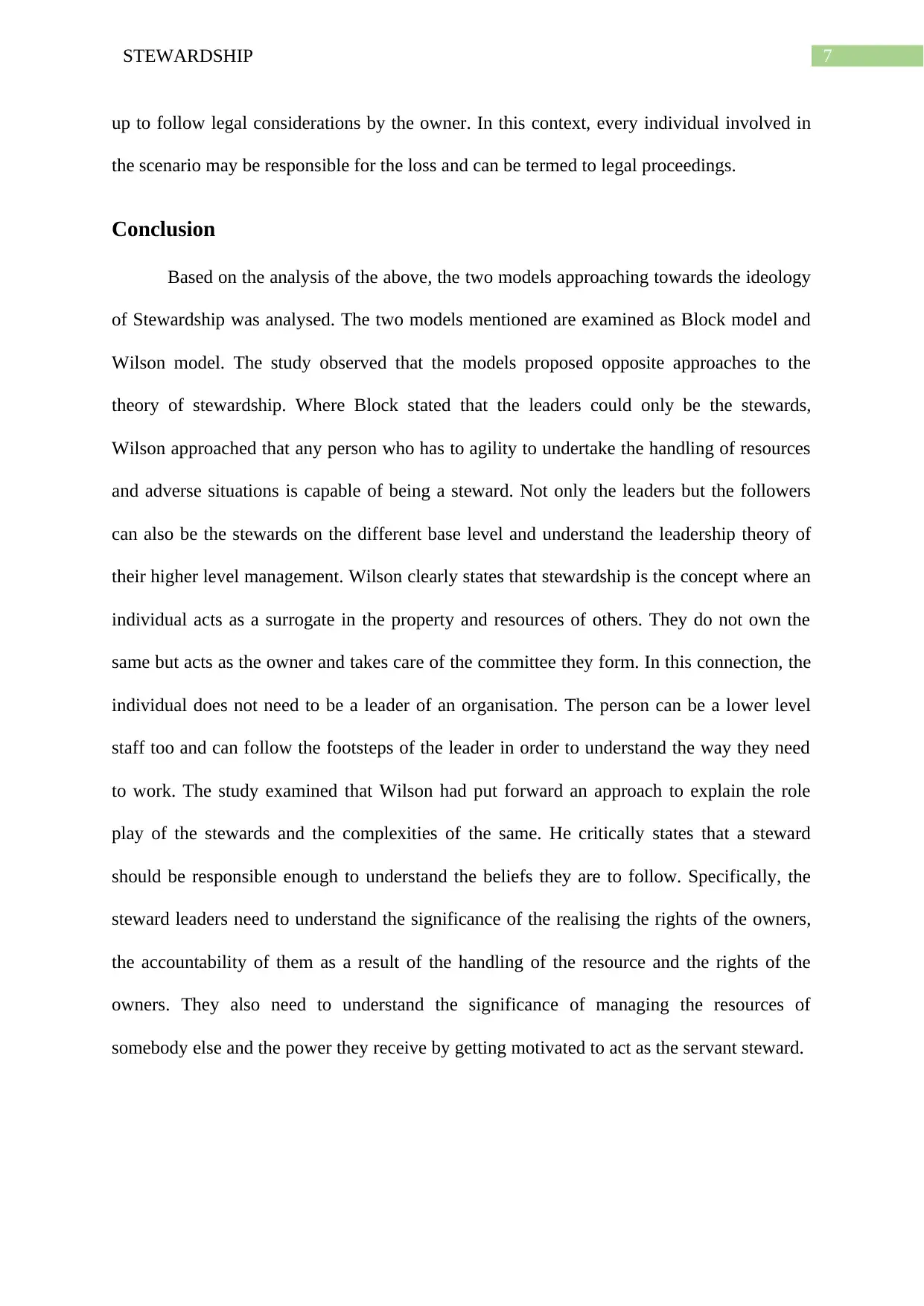
7STEWARDSHIP
up to follow legal considerations by the owner. In this context, every individual involved in
the scenario may be responsible for the loss and can be termed to legal proceedings.
Conclusion
Based on the analysis of the above, the two models approaching towards the ideology
of Stewardship was analysed. The two models mentioned are examined as Block model and
Wilson model. The study observed that the models proposed opposite approaches to the
theory of stewardship. Where Block stated that the leaders could only be the stewards,
Wilson approached that any person who has to agility to undertake the handling of resources
and adverse situations is capable of being a steward. Not only the leaders but the followers
can also be the stewards on the different base level and understand the leadership theory of
their higher level management. Wilson clearly states that stewardship is the concept where an
individual acts as a surrogate in the property and resources of others. They do not own the
same but acts as the owner and takes care of the committee they form. In this connection, the
individual does not need to be a leader of an organisation. The person can be a lower level
staff too and can follow the footsteps of the leader in order to understand the way they need
to work. The study examined that Wilson had put forward an approach to explain the role
play of the stewards and the complexities of the same. He critically states that a steward
should be responsible enough to understand the beliefs they are to follow. Specifically, the
steward leaders need to understand the significance of the realising the rights of the owners,
the accountability of them as a result of the handling of the resource and the rights of the
owners. They also need to understand the significance of managing the resources of
somebody else and the power they receive by getting motivated to act as the servant steward.
up to follow legal considerations by the owner. In this context, every individual involved in
the scenario may be responsible for the loss and can be termed to legal proceedings.
Conclusion
Based on the analysis of the above, the two models approaching towards the ideology
of Stewardship was analysed. The two models mentioned are examined as Block model and
Wilson model. The study observed that the models proposed opposite approaches to the
theory of stewardship. Where Block stated that the leaders could only be the stewards,
Wilson approached that any person who has to agility to undertake the handling of resources
and adverse situations is capable of being a steward. Not only the leaders but the followers
can also be the stewards on the different base level and understand the leadership theory of
their higher level management. Wilson clearly states that stewardship is the concept where an
individual acts as a surrogate in the property and resources of others. They do not own the
same but acts as the owner and takes care of the committee they form. In this connection, the
individual does not need to be a leader of an organisation. The person can be a lower level
staff too and can follow the footsteps of the leader in order to understand the way they need
to work. The study examined that Wilson had put forward an approach to explain the role
play of the stewards and the complexities of the same. He critically states that a steward
should be responsible enough to understand the beliefs they are to follow. Specifically, the
steward leaders need to understand the significance of the realising the rights of the owners,
the accountability of them as a result of the handling of the resource and the rights of the
owners. They also need to understand the significance of managing the resources of
somebody else and the power they receive by getting motivated to act as the servant steward.
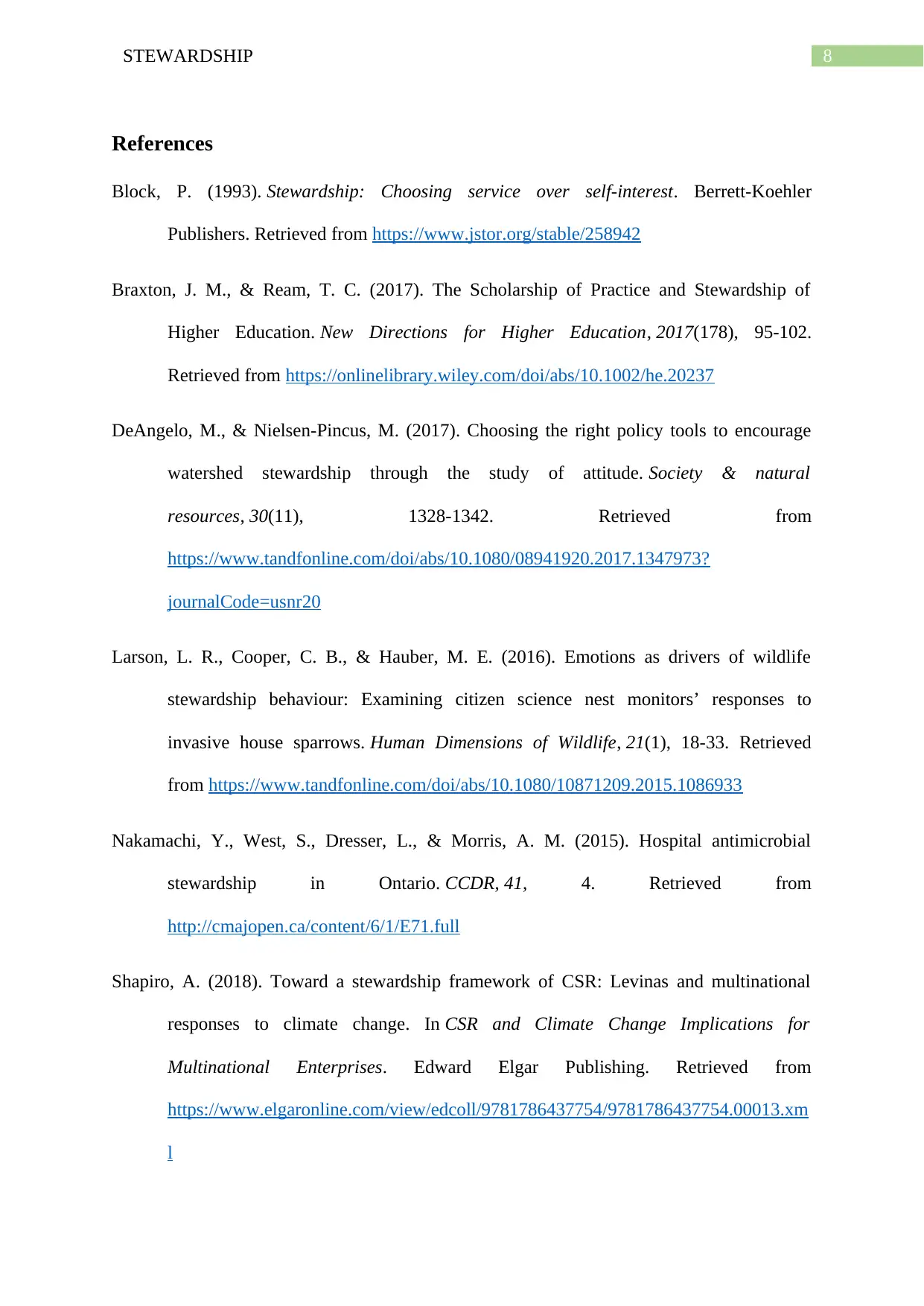
8STEWARDSHIP
References
Block, P. (1993). Stewardship: Choosing service over self-interest. Berrett-Koehler
Publishers. Retrieved from https://www.jstor.org/stable/258942
Braxton, J. M., & Ream, T. C. (2017). The Scholarship of Practice and Stewardship of
Higher Education. New Directions for Higher Education, 2017(178), 95-102.
Retrieved from https://onlinelibrary.wiley.com/doi/abs/10.1002/he.20237
DeAngelo, M., & Nielsen-Pincus, M. (2017). Choosing the right policy tools to encourage
watershed stewardship through the study of attitude. Society & natural
resources, 30(11), 1328-1342. Retrieved from
https://www.tandfonline.com/doi/abs/10.1080/08941920.2017.1347973?
journalCode=usnr20
Larson, L. R., Cooper, C. B., & Hauber, M. E. (2016). Emotions as drivers of wildlife
stewardship behaviour: Examining citizen science nest monitors’ responses to
invasive house sparrows. Human Dimensions of Wildlife, 21(1), 18-33. Retrieved
from https://www.tandfonline.com/doi/abs/10.1080/10871209.2015.1086933
Nakamachi, Y., West, S., Dresser, L., & Morris, A. M. (2015). Hospital antimicrobial
stewardship in Ontario. CCDR, 41, 4. Retrieved from
http://cmajopen.ca/content/6/1/E71.full
Shapiro, A. (2018). Toward a stewardship framework of CSR: Levinas and multinational
responses to climate change. In CSR and Climate Change Implications for
Multinational Enterprises. Edward Elgar Publishing. Retrieved from
https://www.elgaronline.com/view/edcoll/9781786437754/9781786437754.00013.xm
l
References
Block, P. (1993). Stewardship: Choosing service over self-interest. Berrett-Koehler
Publishers. Retrieved from https://www.jstor.org/stable/258942
Braxton, J. M., & Ream, T. C. (2017). The Scholarship of Practice and Stewardship of
Higher Education. New Directions for Higher Education, 2017(178), 95-102.
Retrieved from https://onlinelibrary.wiley.com/doi/abs/10.1002/he.20237
DeAngelo, M., & Nielsen-Pincus, M. (2017). Choosing the right policy tools to encourage
watershed stewardship through the study of attitude. Society & natural
resources, 30(11), 1328-1342. Retrieved from
https://www.tandfonline.com/doi/abs/10.1080/08941920.2017.1347973?
journalCode=usnr20
Larson, L. R., Cooper, C. B., & Hauber, M. E. (2016). Emotions as drivers of wildlife
stewardship behaviour: Examining citizen science nest monitors’ responses to
invasive house sparrows. Human Dimensions of Wildlife, 21(1), 18-33. Retrieved
from https://www.tandfonline.com/doi/abs/10.1080/10871209.2015.1086933
Nakamachi, Y., West, S., Dresser, L., & Morris, A. M. (2015). Hospital antimicrobial
stewardship in Ontario. CCDR, 41, 4. Retrieved from
http://cmajopen.ca/content/6/1/E71.full
Shapiro, A. (2018). Toward a stewardship framework of CSR: Levinas and multinational
responses to climate change. In CSR and Climate Change Implications for
Multinational Enterprises. Edward Elgar Publishing. Retrieved from
https://www.elgaronline.com/view/edcoll/9781786437754/9781786437754.00013.xm
l
⊘ This is a preview!⊘
Do you want full access?
Subscribe today to unlock all pages.

Trusted by 1+ million students worldwide
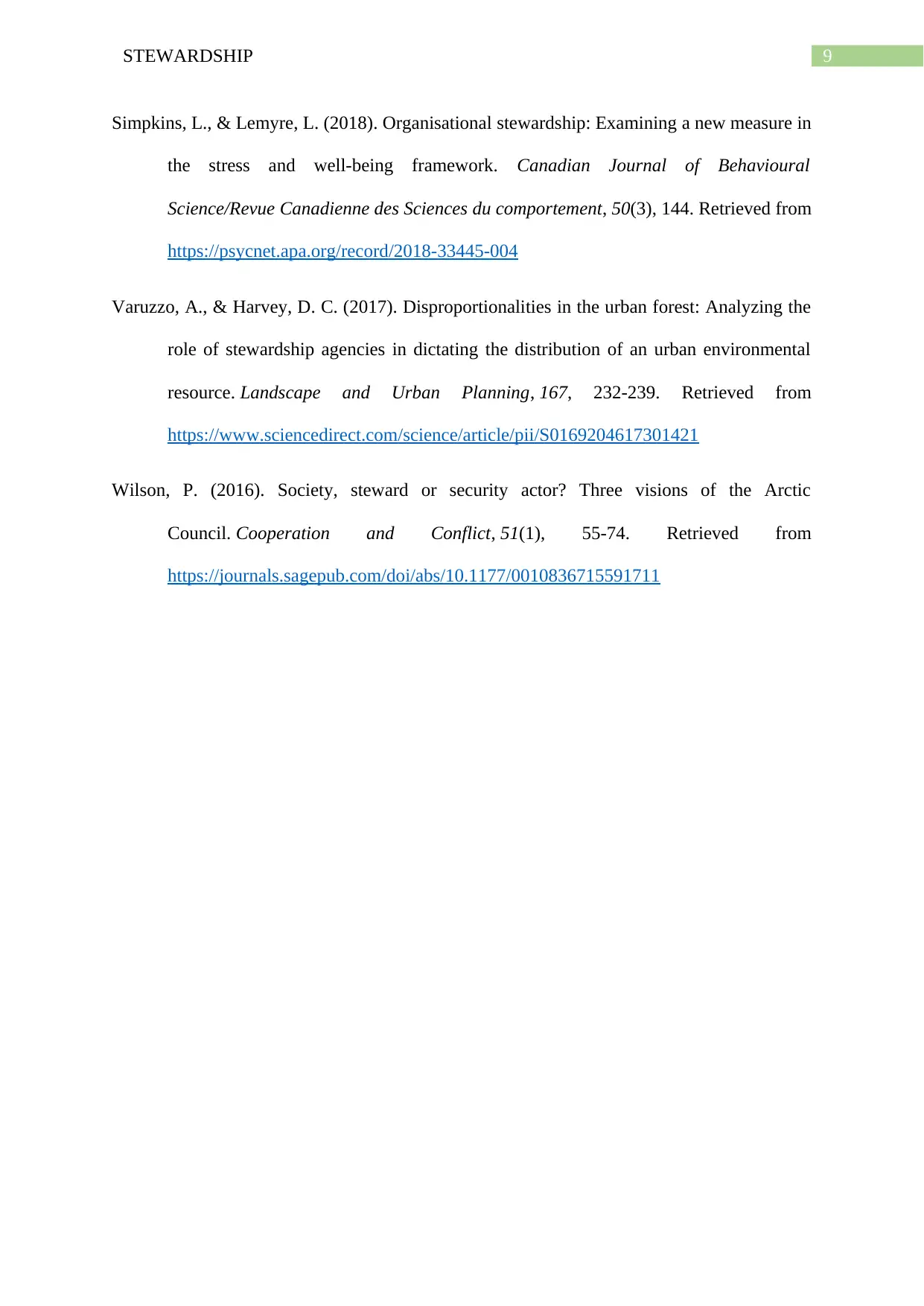
9STEWARDSHIP
Simpkins, L., & Lemyre, L. (2018). Organisational stewardship: Examining a new measure in
the stress and well-being framework. Canadian Journal of Behavioural
Science/Revue Canadienne des Sciences du comportement, 50(3), 144. Retrieved from
https://psycnet.apa.org/record/2018-33445-004
Varuzzo, A., & Harvey, D. C. (2017). Disproportionalities in the urban forest: Analyzing the
role of stewardship agencies in dictating the distribution of an urban environmental
resource. Landscape and Urban Planning, 167, 232-239. Retrieved from
https://www.sciencedirect.com/science/article/pii/S0169204617301421
Wilson, P. (2016). Society, steward or security actor? Three visions of the Arctic
Council. Cooperation and Conflict, 51(1), 55-74. Retrieved from
https://journals.sagepub.com/doi/abs/10.1177/0010836715591711
Simpkins, L., & Lemyre, L. (2018). Organisational stewardship: Examining a new measure in
the stress and well-being framework. Canadian Journal of Behavioural
Science/Revue Canadienne des Sciences du comportement, 50(3), 144. Retrieved from
https://psycnet.apa.org/record/2018-33445-004
Varuzzo, A., & Harvey, D. C. (2017). Disproportionalities in the urban forest: Analyzing the
role of stewardship agencies in dictating the distribution of an urban environmental
resource. Landscape and Urban Planning, 167, 232-239. Retrieved from
https://www.sciencedirect.com/science/article/pii/S0169204617301421
Wilson, P. (2016). Society, steward or security actor? Three visions of the Arctic
Council. Cooperation and Conflict, 51(1), 55-74. Retrieved from
https://journals.sagepub.com/doi/abs/10.1177/0010836715591711
1 out of 10
Related Documents
Your All-in-One AI-Powered Toolkit for Academic Success.
+13062052269
info@desklib.com
Available 24*7 on WhatsApp / Email
![[object Object]](/_next/static/media/star-bottom.7253800d.svg)
Unlock your academic potential
Copyright © 2020–2025 A2Z Services. All Rights Reserved. Developed and managed by ZUCOL.



